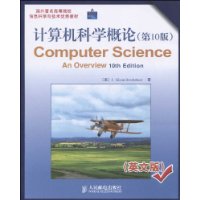| 商家名称 |
信用等级 |
购买信息 |
订购本书 |
|
|
 |
计算机科学概论(第10版)(英文版) |
 |
|
 |
计算机科学概论(第10版)(英文版) |
 |

基本信息·出版社:人民邮电出版社
·页码:666 页
·出版日期:2009年09月
·ISBN:7115211167/9787115211163
·条形码:9787115211163
·版本:第1版
·装帧:平装
·开本:16
·正文语种:英语
·丛书名:国外著名高等院校信息科学与技术优秀教材
·外文书名:Computer Science An Overview 10th Edition
内容简介 《计算机科学概论(第10版)(英文版)》是计算机科学导论课程的一本经典教材,全书对计算机科学做了精彩的百科全书式的全面阐述,全景式地展现了计算机科学的发展历程、现状及其新的技术发展趋势。《计算机科学概论(第10版)(英文版)》首先介绍的是信息编码及计算机体系结构的基本原理(第1章和第2章);进而是操作系统(第3章)和计算机网络(第4章)的内容,接着探讨了算法、程序设计语言及软件开发(第5章~第7章),然后探索了数据结构和数据库(第8章和第9章)方面的问题,第10章通过图形讲述计算机技术的主要应用,第11章涉及人工智能,第12章阐述了计算机抽象理论。
《计算机科学概论(第10版)(英文版)》在内容编排上遵循由具体到抽象推进这样一种很利于教学的顺序,每一个主题自然而然地引导出下一个主题。此外,书中还有大量的图、表和实例,增强了读者对知识的了解与把握。
《计算机科学概论(第10版)(英文版)》既适合作为高等院校计算机以及相关专业本科生教材,也可以供有意在计算机方面发展的非计算机专业读者作为入门参考。
作者简介 J.Glenn Brooksherar,是世界知名的计算机科学教育家。他在1975年获得新墨西哥州立大学博士学位后,创立了Marquette大学的计算机科学学位项目,并在该校任教至今。他的主要研究方向是计算理论。除了本书之外,他还著有Theory of Computation:Forma/Languages,Automata,and Complexity。
编辑推荐 《计算机科学概论(第10版)(英文版)》多年来一直深受世界各国高校师生的欢迎,是许多著名大学(包括美国哈佛大学、麻省理工学院、普林斯顿大学、加州大学伯克利分校等)的首选教材,对我国的高校教学也产生了广泛影响。
《计算机科学概论(第10版)(英文版)》以历史的眼光,从发展的角度、当前的水平,以及现阶段的研究方向等几个方面,全景式地描绘了计算机科学各个子学科的主要领域。在内容编排上,《计算机科学概论(第10版)(英文版)》很好地兼顾了学科广度和主题深度,把握了最新的技术趋势。《计算机科学概论(第10版)(英文版)》用算法、数据抽象等核心思想贯穿各个主题,并且充分展现了历史背景、发展历程和新的技术趋势,培养读者的大局观,为今后深入学习其他计算机专业教程打下坚实的基础。《计算机科学概论(第10版)(英文版)》深入浅出、图文并茂,内容引人入胜,极易引发读者的兴趣,绝无一般教材的枯燥和晦涩。此外,《计算机科学概论(第10版)(英文版)》教学手段多样、习题丰富,并且每章后都附有与本章内容相关的社会现实问题供读者思考和讨论,这些都很好地体现了作者强调培养学生分析问题的能力的教学理念。
《计算机科学概论(第10版)(英文版)》为最新的第10版,其中新增加了关于计算机图形学的一章(第10章),这一章主要介绍视频游戏和当今电影产业中使用的技术,为读者进一步了解虚拟现实打下了基础。此外,这一版对组网及因特网、软件工程、人工智能等章节也做了大幅修订,使内容与时俱进。
《计算机科学概论(第10版)(英文版)》适合各个学科以及不同教育层次的读者,既适合国内高等院校用作计算机基础课教材,也可以供其他专业的读者作为计算机科学入门参考。
目录 Chapter 0 Introduction 1
0.1 The Role of Algorithms 2
0.2 The Origins of Computing Machines 5
0.3 The Science of Algorithms 10
0.4 Abstraction 11
0.5 An Outline of Our Study 12
0.6 Social Repercussions 14
Chapter 1 Data Storage 19
1.1 Bits and Their Storage 20
1.2 Main Memory 27
1.3 Mass Storage 30
1.4 Representing Information as Bit Patterns 38
*1.5 The Binary System 45
*1.6 Storing Integers 50
*1.7 Storing Fractions 58
*1.8 Data Compression 62
*1.9 Communication Errors 68
Chapter 2 Data Manipulation 81
2.1 Computer Architecture 82
2.2 Machine Language 85
2.3 Program Execution 92
*2.4 Arithmetic/Logic Instructions 100
*2.5 Communicating with Other Devices 105
*2.6 Other Architectures 110
Chapter 3 Operating Systems 121
3.1 The History of Operating Systems 122
3.2 Operating System Architecture 126
3.3 Coordinating the Machine's Activities 134
*3.4 Handling Competition Among Processes 138
3.5 Security 143
Chapter 4 Networking and the Internet 151
4.1 Network Fundamentals 152
4.2 The Internet 162
4.3 The World Wide Web 171
*4.4 Internet Protocols 181
4.5 Security 188
Chapter 5 Algorithms 203
5.1 The Concept of an Algorithm 204
5.2 Algorithm Representation 207
5.3 Algorithm Discovery 215
5.4 Iterative Structures 222
5.5 Recursive Structures 233
5.6 Efficiency and Correctness 242
Chapter 6 Programming Languages 261
6.1 Historical Perspective 262
6.2 Traditional Programming Concepts 271
6.3 Procedural Units 284
6.4 Language Implementation 292
6.5 Object-Oriented Programming 301
*6.6 Programming Concurrent Activities 309
*6.7 Declarative Programming 311
Chapter 7 Software Engineering 325
7.1 The Software Engineering Discipline 326
7.2 The Software Life Cycle 329
7.3 Software Engineering Methodologies 334
7.4 Modularity 336
7.5 Tools of the Trade 345
7.6 Quality Assurance 353
7.7 Documentation 357
7.8 The Human-Machine Interface 359
7.9 Software Ownership and Liability 362
Chapter 8 Data Abstractions 371
8.1 Basic Data Structure 372
8.2 Related Concepts 376
8.3 Implementing Data Structures 378
8.4 A Short Case Study 395
8.5 Customized Data Types 401
*8.6 Classes and Objects 404
*8.7 Pointers in Machine Language 406
Chapter 9 Database Systems 417
9.1 Database Fundamentals 418
9.2 The Relational Model 423
*9.3 Object-Oriented Databases 436
*9.4 Maintaining Database Integrity 439
*9.5 Traditional File Structures 443
9.6 Data Mining 452
9.7 Social Impact of Database Technology 454
Chapter 10 Computer Graphics 463
10.1 The Scope of Computer Graphics 464
10.2 Overview of 3D Graphics 466
10.3 Modeling 469
10.4 Rendering 478
*10.5 Dealing with Global Lighting 490
10.6 Animation 493
Chapter 11 Artificial Intelligence 503
11.1 Intelligence and Machines 504
11.2 Perception 509
11.3 Reasoning 515
11.4 Additional Areas of Research 528
11.5 Artificial Neural Networks 533
11.6 Robotics 542
11.7 Considering the Consequences 545
Chapter 12 Theory of Computation 555
12.1 Functions and Their Computation 556
12.2 Turing Machines 558
12.3 Universal Programming Languages 563
12.4 A Noncomputable Function 569
12.5 Complexity of Problems 575
*12.6 Public-Key Cryptography 585
Appendixes 595
A ASCII 597
B Circuits to Manipulate Two's Complement Representations 598
C A Simple Machine Language 601
D High-Level Programming Languages 604
E The Equivalence of Iterative and Recursive Structures 607
F Answers to Questions & Exercises 609
Index 655
……
序言 在计算机学科的大学教育中,有一门重要的课程,即该学科各专业的学生都必须学习的一门专业基础课,在我国一般称作“计算机概论”。学生从中学进入大学,开始正规而系统地学习计算机专业课程,需要首先对计算机科学技术的基础知识有一个概括而准确的了解,否则学习其他任何一门专业课都会遇到许多障碍。所以这门课程对于计算机软件与理论、计算机体系结构、计算机应用技术等专业的教学都是非常重要的。
J.Glenn Brookshear著的《计算机科学概论》(Computer Science;An Overview)就是这样一本适合作为上述课程教材的好书。该书在美国哈佛大学、加州大学等各所大学被采用。自第一版之后,作者根据计算机科学技术的新发展不断地对该书进行更新和补充,目前已经是第10版。书中介绍了计算机硬件、软件、数据库和计算理论等方面的内容。对这些内容的论述深浅适当,文字通俗易懂且简练和准确;每一节都有精心设计的习题;颇具匠心给出的插图,很好地表现了书中阐述的内容。总之,这是一本很值得引进和推广的好教材。
在我国,改革开放以来计算机科学技术的学科建设和教材建设一直在稳步发展。各高校的教师为此付出了大量心血,写作出版了许多高质量的教材。其中有许多教材不但具有很好的学术水平,而且适合我国的国情与文化背景。同时,学习和借鉴国际上先进的科学技术和优秀文化,是培养人才的需要。有选择地引进国外的优秀教材,必将有效地促进我国教育事业的健康发展。这本书的影印出版,将对我国的计算机专业基础课的教学和教材建设起到良好的作用。它也可以用于非计算机专业的计算机教学和计算机产业界的技术培训。
文摘 插图:

Another example occurs when using the services of a search engine. In thiscase a user at the client specifies a topic of interest (a client-side activity) whichis then transferred to the search engine where a customized Web page identifyingdocuments of possible interest is constructed (a server-side activity) and sentback to the client. Still another example occurs in the case of Web mail-an in-creasingly popular means by which computer users are able to access theiremail by means of Web browsers. In this case, the Web server is an intermediarybetween the client and the client's mail server. Essentially, the Web server buildsWeb pages that contain information from the mail server (a server-side activity)and sends those pages to the client where the client's browser displays them (aclient-side activity). Conversely, the browser allows the user to create messages(a client-side activity) and sends that information to the Web server, which thenforwards the messages to the mail server (a server-side activity) for mailing.
There are numerous systems for performing client- and server-side activi-ties, each competing with the others for prominence. An early and still popularmeans of controlling client-side activities is to include programs written in thelanguage JavaScript (developed by Netscape Communications, Inc.) withinthe HTML source document for the Web page. From there a browser can extractthe programs and follow them as needed. Another approach (developed by SunMicrosystems) is to first transfer a Web page to a browser and then transfer addi-tional program units called applets (written in the language Java) to the browseras requested within the HTML source document. Still another approach is thesystem Flash (developed by Macromedia) by which extensive multimedia client-side presentations can be implemented.
An early means of controling server-side activities was to use a set of
……





